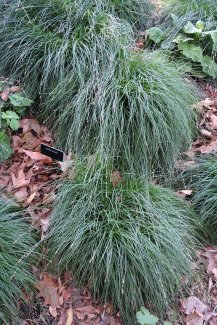AFRICA Macaronesia: Spain - Canary Islands Northern Africa: Algeria; Morocco; Tunisia
ASIA-TEMPERATE Western Asia: Cyprus; Iran; Jordan; Syria; Turkey Caucasus: Armenia; Azerbaijan; Georgia; Russian Federation - Ciscaucasia, Dagestan Middle Asia: Turkmenistan
EUROPE Northern Europe: Ireland; United Kingdom Middle Europe: Austria; Belgium; Czech Republic; Germany; Hungary; Netherlands; Poland; Slovakia; Switzerland East Europe: Russian Federation - European part; Ukraine Southeastern Europe: Albania; Bosnia and Herzegovina; Bulgaria; Croatia; Greece; Italy; Macedonia; Montenegro; Romania; Serbia; Slovenia Southwestern Europe: France; Portugal; Spain
Evergreen, arching clumps of fine, grass-green leaves…12-18" tall by 2' wide. Very versatile, takes full sun in the north and on the coast to fairly deep shade inland and in hot summer areas. Typical sedge 'flowers' add interest and may reseed in irrigated areas. Tough, will grow with root competition but needs ample water, thrives in coastal conditions..forms a resilient ground cover in the shade that takes occasional mowing.
Caespitose 15-90 cm, forming small tufts, with short stolons. Stem sharply trigonous above, edges scabrous. Leaves soft, from c. ½ to as long as stem; sheaths 15-40 mm, whitish to grey-brown or reddish, margin of scarious side concave or straight; ligule 0.1-0.2 mm, arch as high as wide or higher; blades 2-3.5 mm wide, flat, wrinkled along main veins, adaxial side smooth or +/- papillose, basal baxial side smooth , margins, apex and mid-vein scabrous. Inflorescence 30-70 mm, of 3-8(-15) androgynous spikes, overlapping or a few lowest distant, lowest branch sometimes elongate and with several spikes. Bracts sheathless, glume-like or at most as long as their spike, very narrow, green, scabrous. Spikes globular, 5-7 mm diam., green, later light brown; glumes 2.5-4.6 x 1.3-2.5 mm, ovate, obtuse to acute or frequently with mucro up to 0.5 mm, mid-vein white, surrounded by green area, bordered by two, white, conspicuous veins, margins scarious; utricles 3.3-5.4 x 1.5 mm, plano-convex, narrowly ovoid, narrowly winged. brownish, adaxial side without veins, glossy, baxial side without or with few veins, sometimes with short stipe 0.2-0.3 mm, beak green, winged, 1-2.3 mm, with two long, sharp teeth, ostiole white-margined. Nut 1.7-2.7 x 1.4-1.9 mm, bi-convex or planoconvex, widely ovoid to ellipsoid, glossy, finely verrucose.
During 2005, Rick Darke, known for his work with ornamental grasses, graciously arranged to have Dr Tony Reznicek of the University of Michigan Herbarium examine fresh Berkeley sedge material from California. Dr Reznicek is a Carex expert and author of Carex treatments for the new multi-volume Flora of North America North of Mexico. In late November, 2005, Dr Reznicek provided his determination that Berkeley sedge is actually C. divulsa, first described in 1787 from the British Isles, where it is known as grey sedge or grassland sedge, not synonymous with Gray’s sedge (C. grayi) nor gray sedge (C. grisea), both of eastern North America. Grey sedge (C. divulsa) is native from Europe and North Africa east to Central Asia. Naturalized stands are known from Canada (Ontario), United States (Pennsylvania, Mary-land, Missouri, California), Argentina, Australia, and New Zealand. - See more at: http://www.pacifichorticulture.org/articles/berkeley-sedge-is-eurasian-…
